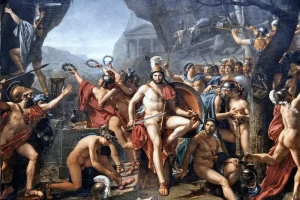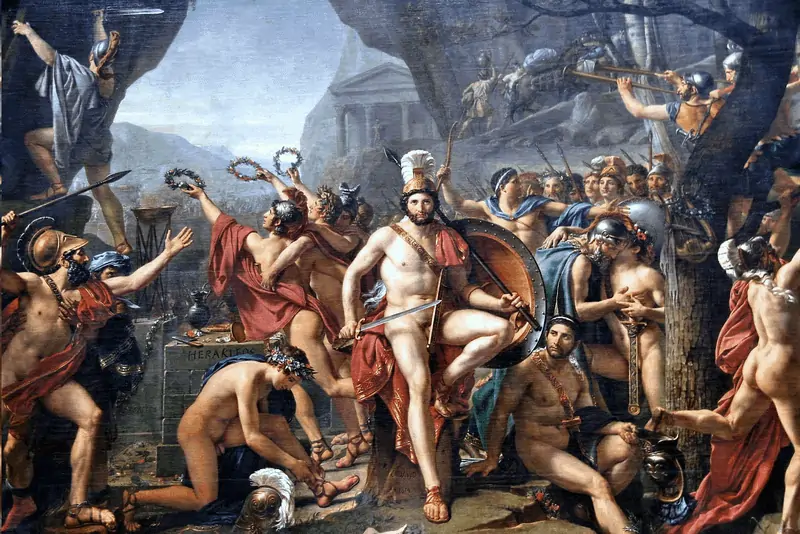The historical texts by Xenophon (430-355 BCE) are the subject of a close study here by Rosie Harman, Lecturer in Greek Historiography, University College London. But her take on Xenophon is unlike any other, as she exposes the “visual transparency of Greek identity” where others merely see a solid wall of shields on the battlefield.
In a book about viewing, the author missed the opportunity to engage with ‘modern’ paintings that depict ancient Greek warriors. An ideal subject for analysis would have been the one shown in this review. Done in 1812, it is by Jacques-Louis David. When Harman writes “Xenophon’s viewers often risk being overwhelmed by the impressive, but deceptive, displays of powerful figures,” the image of the Spartan leader Leonidas (540-480 BCE) immediately comes to mind.
Now since Harman states this book looks at Greece in the early 4th century BCE (roughly from 400 to 360 BCE), you might say that an image of Leonidas is far too early to merit attention. But one of the texts of Xenophon examined in this book is about Cyrus the Great of Persia (590-529 BCE), an even earlier figure! Thus, the very first line of chapter one is misleading. Furthermore, she makes a point of studying prior models for Xenophon, namely Herodotus and Thucydides, both from the 5th century BCE.
Leonidas exemplifies much of what she describes, and since the fourth century BCE opened with “the continuing rise of Spartan power,” the link with the past century is strong.
Harman writes about Plutarch, who “indicates how Xenophon’s use of the visual allows the reader to participate in the experiences of the historical protagonists: the reader becomes a vicarious spectator, experiencing events through their eyes. Importantly, the experiences of Xenophon’s spectators are often highly politicised: visual interaction structures political or military conflict.” All these elements are starkly on display in the painting. In David’s work a warrior pauses at the heart of a vast battle. While Greeks and Persians clash all around him, the Spartan hero Leonidas contemplates the meaning of it all – and his philosophical moment is expressed physically. His perfect body is a Greek statue come to life, and his look is the personification of the male gaze.
Harman says that “in the representation of visual encounters, just as the literary protagonists’ response becomes a cultural or political response, so too the reader is challenged to formulate their own cultural or political relationship to the protagonists and their historical situation.” That is certainly the case for the reader of Xenophon. While her focus is quite rightly on the ancient texts, I think the inclusion of the David painting would have bolstered her case. In the event, there are no illustrations in the book, save for a front cover 19th century drawing of Xenophon and the Greeks Sighting the Sea. Thus, the inclusion of a 19th century painting would not have transgressed the boundaries set by the publisher.
Xenophon’s Hellenica is an ideal place to start. A “spectacular sight frequently described in the Hellenica is the spectacle of the successful Greek leader. Many such moments appear in accounts of Spartan action… Such moments of spectacle invite the pleasure and identification of the reader. In its focus on powerful individuals, the Hellenica offers the possibility to its male elite ideal reader of self-imagination as one of the ‘makers of history.’”
Harman singles out the Hellenica as a key text for her project here. “The Hellenica’s spectacularization of Spartan commanders in their use of militarily deliberate display both invites identification with Spartan supremacy and simultaneously alienates the non-Spartan reader confronted with the dangerous threat of Sparta.” Suggesting that this dichotomy and the naked spectacle of Spartan power has not been fully appreciated, Harman offers an important caution. “To downplay the shocks and intellectual struggles which these texts impose is to miss an important part of what makes them interesting.” She refers here not just to Hellenica, but Anabasis and Cycropedia, all by Xenophon.
For Lucian (125-180 CE), all of whose works are in Greek, Xenophon was surely an inspiration as he praised the energy of Xenophon’s writing. For him, writes Harman, “the ideal historian expresses his account vividly and allows the reader to see the events described; he compares the ideal historian to Pheidias, suggesting that like the sculptor, the ideal historian produces work which operates visually.” Harman wisely delves into the Greek language to uncover a key expression of this. “The trustworthiness of sight as a path to knowledge could be both asserted and questioned; the derivation of the Greek verb ‘I know’ from the perfect tense of the verb that means ‘I see’ suggests their close connection in Greek thought.”
She relates this analysis directly to the writing of Xenophon. “In his interest in the problem of correctly interpreting sights, in the relationship between display and political power and in the difficulties of responding to sights in a culturally diverse or politically conflicted environment, he is participating in and contributing to contemporary political debates.”
The Greeks were not the only ones to exploit the visual. Cyrus of Persia and his men “are presented as impressive spectacles of elite masculine endeavour…and the outstandingly beautiful appearance of Cyrus himself” is emphasised. “The staging of Cyrus’ superior knowledge frames the tactics of visual effect as both important and difficult to master, and reveals Cyrus as an expert.” Expanding on this insight, Harman engagingly writes “Through the slippage between display as performance and display as revelation, Cyrus’ virtuous display is open to be understood as a contrivance performed as a mechanism of rule, but also as a display of real attributes.” Xenophon himself writes that while “the modest avoid shameful actions when visible, the self-controlled (i.e. Cyrus) also do so when unseen.”
The homoerotic nature of much of what Xenophon writes is obvious, although Harman doesn’t spill much ink on it. She does note the meeting of Artabazus with the young Cyrus. She describes it as an “early erotic encounter.” Artabazus was smitten, “so overcome by the sight of Cyrus that he is scarcely able to look away.” Xenophon writes “Don’t you know Cyrus that even the time it takes me to blink seems an eternity to me, because during that time I do not see you, who are so handsome?” Taking control of the ‘male gaze’ from Artabazus, Cyrus promises to return so that it would be possible for Artabazus “to look at him, if he wished, without blinking.” Sounds like a scene from an Italian 1950s B-grade movie about ancient times.
A fascinating and innovative study of the power of visual representation in ancient Greece, I highly recommend this book.
The Politics of Viewing in Xenophon’s Historical Narratives is by Bloomsbury. It lists for US$103.50.
Image: Leonidas at Thermopylae is in The Louvre.
For another recent book I reviewed on Xenophon, go to this link:
https://sunnewsaustin.com/2023/03/18/xenophons-irony/

